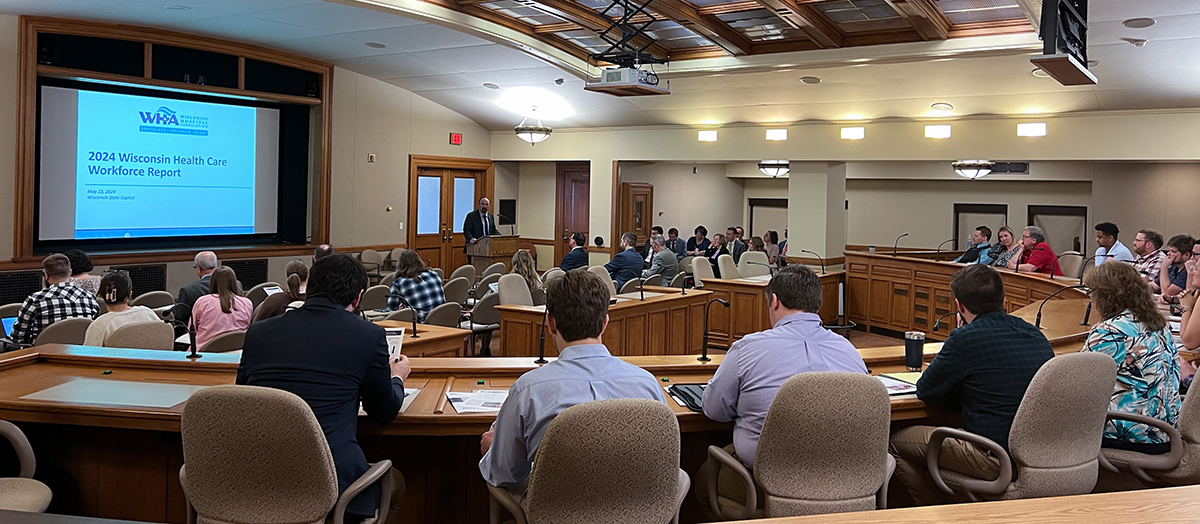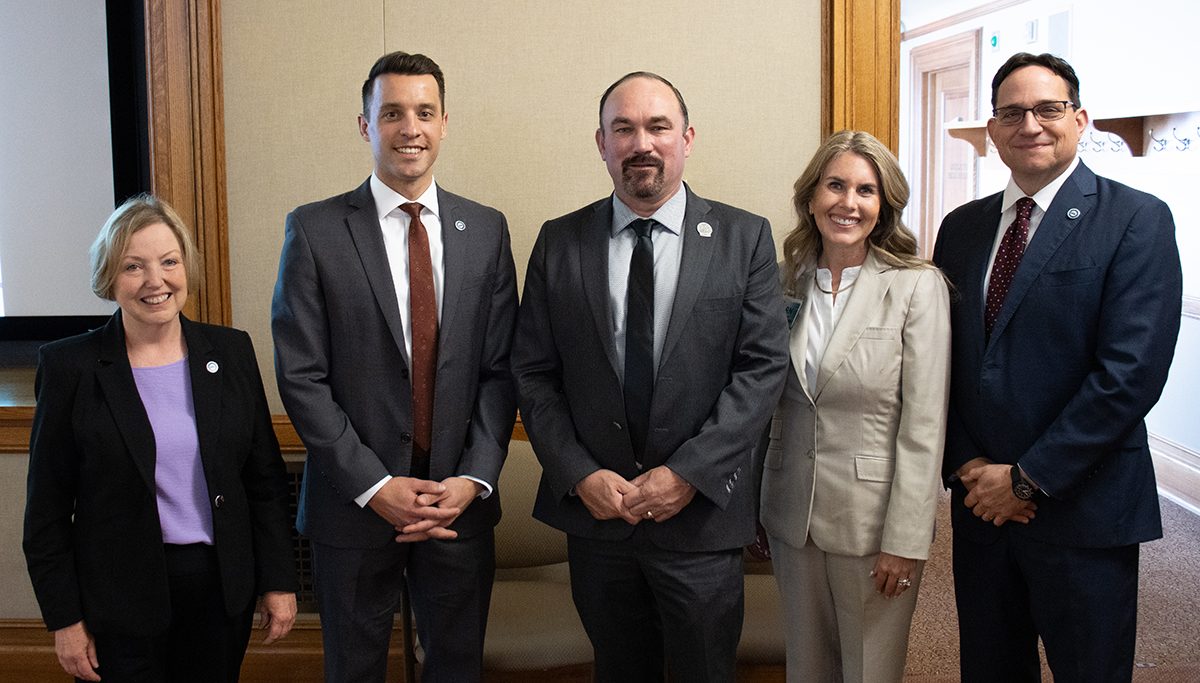The chairs and ranking members of the Wisconsin Legislature’s Senate Committee on health and the Assembly Committee on Health, Aging and Long-Term Care hosted a Wisconsin Hospital Association (WHA) workforce legislative briefing for state policymakers and staff May 23, 2024, at the state capitol in Madison, and streamed live on WisconsinEye.
 WHA’s workforce legislative briefing at the state capitol, May 23, 2024.
WHA’s workforce legislative briefing at the state capitol, May 23, 2024.
WHA CEO Eric Borgerding and WHA Senior Vice President Workforce and Clinical Practice shared findings and recommendations from
WHA’s 2024 Wisconsin Health Care Workforce Report. Tamarack Health’s President and CEO Luke Beirl and Emplify Health’s Gundersen Region President Heather Schimmers joined Borgerding and Zenk and provided real-world examples of how WHA members are growing, supporting and sustaining their own workforce, and how the tools and resources provided by the state Legislature have assisted in those efforts.
State Sens. Rachael Cabral-Guevara and LaTonya Johnson and State Reps. Clint Moses and Lisa Subeck invited state legislators and legislative staff to join them in discussing the issues facing health care and the health care workforce, and more importantly, discovering the solutions and how sound health care policy strengthens the health care workforce and assists policymakers in addressing current and future health care needs. More than 100 legislators and staff were in the audience or tuned in via the
Wisconsin Eye stream.
Moses opened the briefing noting “The multi-disciplinary team, and having the right professionals to care for people, is very important.” Rep. Moses encouraged his colleagues to help, saying, “We rely on organizations like WHA for their expertise to help us understand what we can do to meet these challenges.”
Borgerding provided an overview of the environment and challenges confronting Wisconsin hospitals and health systems and their workforce. He noted that WHA’s workforce report has become a relied-upon guide for policymakers and industry stakeholders and a catalyst for public policy changes that support health care and the health care workforce. Borgerding recognized the value of the Legislature’s much-appreciated partnership in key workforce policy that helps improve health care in Wisconsin: “Thank you for being here, and for everything we have done together; let’s keep going.”
Zenk also thanked the Legislature for their partnership and support, and explained how demographics and the “Silver Tsunami,” as the aging of the very large baby boom generation has been termed, are simultaneously increasing health care demand and shrinking the available workforce. WHA’s workforce expert noted, “Demographics are largely beyond our control, but we can partner on the things within our control. We can help grow the workforce faster, and we can help the workforce we have work to their full potential, relieved of regulatory burden wherever possible.”
After Zenk highlighted the outcomes made possible by the public-private partnerships created by
Grow Our Own GME grants, she turned it over to Beirl to describe how Tamarack hospitals in Hayward and Ashland were able to grow from a few physicians in 2017 to their current 76 employed physicians and advanced practice clinicians. Tamarack’s growth strategy, aided by state funding and Tamarack’s matching funds, relies on partnerships with school districts, tech colleges, medical schools and universities, and requires not only financial investment, but the investment of the health care workforce’s time, energy and expertise. Beirl pointed out “When we see a need, we step up, but it comes at a cost,” adding, “our health care professionals do it, even though it lengthens their day and decreases their efficiency.”
Schimmers was also able to provide Gundersen's workforce journey, and the benefits provided by strong health care policy, like “Grow Our Own” grant funding, licensure compacts, and
2021 Wisconsin Act 10. Schimmers outlined Gundersen’s workforce strategy and investment, noting, “We’re working as hard and as fast as we can, but it’s getting harder and harder with razor thin margins.” Schimmers thanked the state’s legislators for all they have done, including a five-fold increase in funding for “Grow Our Own” Allied Health Training grants
Allied Health training grant program that has assisted Gundersen in growing key segments of their workforce, like medical assistants and nursing assistants, drastically reducing vacancy rates in those areas. She asked them to keep helping, by sustaining “Grow Our Own” funding, increasing Medicaid reimbursement, helping rein in ever-growing payer demands and providing greater flexibility to allow bachelor’s prepared registered nurses an expanded role in education.
 L to R: Ann Zenk, Luke Beirl, Rep. Clint Moses, Heather Schimmers, Eric Borgerding.
L to R: Ann Zenk, Luke Beirl, Rep. Clint Moses, Heather Schimmers, Eric Borgerding.
WHA’s Ann Zenk closed out the briefing by noting, “Expanding educational capacity and creating more training opportunities is important, and it’s just as vital that we keep that educational pipeline full.” Zenk described WHA’s “
So Many Options” health care career promotion social media campaign and website, including the campaign’s school and hospital toolkits and the videos of members of Wisconsin hospital teams sharing the opportunities their health care careers have provided.
You can find more information about Wisconsin’s health care workforce and WHA’s recommendation on
WHA's Workforce Report webpage. Contact WHA’s
Ann Zenk with questions or ideas regarding the health care workforce or WHA’s 2024 Wisconsin Health Care Workforce Report.